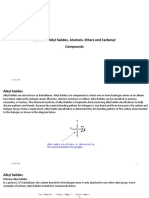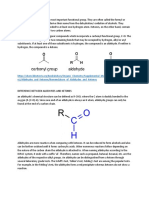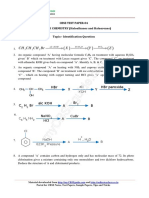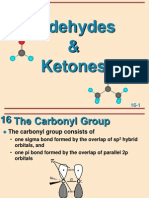Cbse Test Paper-02 CLASS - XII CHEMISTRY (Aldehydes, Ketones and Carboxylic Acids) Topic:-Reasoning Questions. (Answers)
Cbse Test Paper-02 CLASS - XII CHEMISTRY (Aldehydes, Ketones and Carboxylic Acids) Topic:-Reasoning Questions. (Answers)
Uploaded by
Shreyash KolekarCopyright:
Available Formats
Cbse Test Paper-02 CLASS - XII CHEMISTRY (Aldehydes, Ketones and Carboxylic Acids) Topic:-Reasoning Questions. (Answers)
Cbse Test Paper-02 CLASS - XII CHEMISTRY (Aldehydes, Ketones and Carboxylic Acids) Topic:-Reasoning Questions. (Answers)
Uploaded by
Shreyash KolekarOriginal Title
Copyright
Available Formats
Share this document
Did you find this document useful?
Is this content inappropriate?
Copyright:
Available Formats
Cbse Test Paper-02 CLASS - XII CHEMISTRY (Aldehydes, Ketones and Carboxylic Acids) Topic:-Reasoning Questions. (Answers)
Cbse Test Paper-02 CLASS - XII CHEMISTRY (Aldehydes, Ketones and Carboxylic Acids) Topic:-Reasoning Questions. (Answers)
Uploaded by
Shreyash KolekarCopyright:
Available Formats
CBSE TEST PAPER-02
CLASS - XII CHEMISTRY (Aldehydes, Ketones and carboxylic acids)
Topic:- Reasoning Questions.
[ANSWERS]
1. Carboxylic acid on dissociation form carboylate ion which is stabilized by two equivalent
resonance structure in which negative charge is at the more electronegative oxygen
atom, whereas the conjugate base of phenol, phenoxide ion, has non – equivalent
resonance structures in which negative charge is at the less electronegative carbon
atom. Therefore resonance is not as important as it is in carboxylate ion. Moreover the
negative charge is delocalized over two more electronegative oxygen atoms in
carboxylate ion whereas it is less effectively delocalized over one oxygen atom and one
carbon atom in phenoxide ion. Therefore the carboxylate ion is more stabilized than
phenoxide ion and carboxylic acids are stronger acids than phenol.
2. Ethanol can form intermolecular Hydrogen bonding with water molecules, ethyl chloride
can not. Therefore ethanol is soluble in water and ethyl chloride is not.
3. Aldehydes are more reactive than Ketones due to steric and electronic reasons. In
Ketones due to presence of two relatively large alkyl groups, the approach of nucleophile
is more hindered than in aldehydes having only one such substitute. More over the +I
effect of alkyl groups reduces the electophilicity of carbonyl group more in Ketone than
in aldehydes.
4. Carboxylic acids have more extensive association of molecules through intermolecular
hydrogen bonding than alcohols. Moreover their boiling points are higher than alcohols
of same carbon atoms.
5. Ethanoic acid exists as dimer in vapour state in which two molecules remain together by
hydrogen bonding. This increases the effective molecular mass to 120.
6. In carboxylic acids due to presence of resonance, the C=O group is not a pure carbonyl
group & therefore they do not show characteristic reactions of carbonyl group.
7. Formaldehyde does not have any α - hydrogen and therefore it can not show aldol
condensation.
8. In fluoroacetic acid, Fluorine being electron withdrawing group stabilizes the conjugate
base through delocalization of the negative charge
O
F C
O
Therefore fluoroacetic acid is a stronger acid than acetic acid.
Material downloaded from http://myCBSEguide.com and http://onlineteachers.co.in
Portal for CBSE Notes, Test Papers, Sample Papers, Tips and Tricks
You might also like
- CAPE CHEMISTRY UNIT 2-Comparing AciditiesDocument22 pagesCAPE CHEMISTRY UNIT 2-Comparing AciditiesRikkiNo ratings yet
- Crosslinking Reagents Handbook PDFDocument56 pagesCrosslinking Reagents Handbook PDFAlexandraPatricheNo ratings yet
- UntitledDocument15 pagesUntitlednatNo ratings yet
- ORGANIC CHEMISTRY IMPORTANT Q-ANS DGGDGDVDFVBDocument33 pagesORGANIC CHEMISTRY IMPORTANT Q-ANS DGGDGDVDFVBdavegi3069No ratings yet
- Ch-12, Reasonings, 12th ChemDocument2 pagesCh-12, Reasonings, 12th Chemshreyasinghvocals13No ratings yet
- Cbse Test Paper-02 CLASS - XII CHEMISTRY (Alcohols, Phenols and Ethers)Document3 pagesCbse Test Paper-02 CLASS - XII CHEMISTRY (Alcohols, Phenols and Ethers)Shreyash KolekarNo ratings yet
- Aldehydes, Ketones and Carboxylic Acids - GRDocument2 pagesAldehydes, Ketones and Carboxylic Acids - GRAmeen NoushadNo ratings yet
- org reasoning 1and2Document4 pagesorg reasoning 1and2Mansa KaurNo ratings yet
- Alcohols, Phenols and EthersDocument4 pagesAlcohols, Phenols and EthersrheaNo ratings yet
- Science Fair Project: Type Your Project Title Here Your Name Your Teacher's Name Your SchoolDocument290 pagesScience Fair Project: Type Your Project Title Here Your Name Your Teacher's Name Your SchoolmanueveredNo ratings yet
- Alcohols - Reasoning QnsDocument5 pagesAlcohols - Reasoning Qnstanishka0307100% (1)
- Reasoning Questions Organic Chemistry Class XiiDocument6 pagesReasoning Questions Organic Chemistry Class XiipreitaphilenaNo ratings yet
- Precious Organic SolnDocument8 pagesPrecious Organic Solnmwimaandrew2No ratings yet
- Acidic Strength NCERT TheoryDocument6 pagesAcidic Strength NCERT Theorystudydude020No ratings yet
- A2 Carboxylic Acid Notes (Organic)Document24 pagesA2 Carboxylic Acid Notes (Organic)HaniyaNo ratings yet
- CHEMISTRY (ALDEHYDES, KETONES AND CARBOXYLIC ACIDS) Give Reason EditedDocument4 pagesCHEMISTRY (ALDEHYDES, KETONES AND CARBOXYLIC ACIDS) Give Reason EditedRidhanishaa LoganathanNo ratings yet
- Aldehydes, Ketones and Carboxylic Acids Question Bank (Subjective)Document16 pagesAldehydes, Ketones and Carboxylic Acids Question Bank (Subjective)helixvector45411No ratings yet
- ORGANIC Q N A STUDY MATERIAL 2022Document20 pagesORGANIC Q N A STUDY MATERIAL 2022X-D-32 - Shubham RautarayaNo ratings yet
- Aldehydes and Ketones Qs Paper 5Document21 pagesAldehydes and Ketones Qs Paper 5Meenakshi JNo ratings yet
- Organic Give Reasons (2023-24)Document13 pagesOrganic Give Reasons (2023-24)xefayo4337No ratings yet
- Revision Notes For Class 12 CBSE Chemistry, Alcohols, Phenols and Ethers - TopperlearningDocument10 pagesRevision Notes For Class 12 CBSE Chemistry, Alcohols, Phenols and Ethers - TopperlearningRishabh Bhandari75% (4)
- Acidic and Basic Character of Organic CompoundsDocument35 pagesAcidic and Basic Character of Organic CompoundsLoveena Steadman100% (1)
- Organic Reasoning NewDocument27 pagesOrganic Reasoning NewJeyanthiNo ratings yet
- Aldehydes Ketone Carboxylic AcidsDocument4 pagesAldehydes Ketone Carboxylic AcidspoornaNo ratings yet
- CH 05Document31 pagesCH 05nayan159No ratings yet
- Chemistry QuestionDocument9 pagesChemistry QuestiontushargadgetsprpNo ratings yet
- Carbonyl Compounds 2024Document10 pagesCarbonyl Compounds 2024ryyamonizeNo ratings yet
- Carboxylic Acid - NotesDocument16 pagesCarboxylic Acid - NotesVANSHIKA GOELNo ratings yet
- 7h JDYuhrogXcqzyDocument14 pages7h JDYuhrogXcqzyAnoushay KhanNo ratings yet
- Member SinceDocument2 pagesMember Sincethe punisher 1No ratings yet
- Carboxylic Acids ..Document27 pagesCarboxylic Acids ..Mariam HamedNo ratings yet
- Halo 2 3Document15 pagesHalo 2 3linngeshwar BNo ratings yet
- Chemistry 11Document10 pagesChemistry 11catalystgrowthNo ratings yet
- Chemistry Lesson 22 Carboxylic Acids and Therir Derivatives (Autosaved)Document15 pagesChemistry Lesson 22 Carboxylic Acids and Therir Derivatives (Autosaved)muhammad.80918No ratings yet
- Carboxylic Acids - 2023Document15 pagesCarboxylic Acids - 2023Sangay ChodenNo ratings yet
- Lesson 4. Alkyl Halides, Alcohols, Ethers and Carbonyl CompoundsDocument30 pagesLesson 4. Alkyl Halides, Alcohols, Ethers and Carbonyl Compoundsann wamburaNo ratings yet
- CBSE Class 12 Chemistry - Alcohols, Phenols and Ethers AssignmentDocument14 pagesCBSE Class 12 Chemistry - Alcohols, Phenols and Ethers AssignmentmaheshNo ratings yet
- XII Organic Reasoning QuestionsDocument7 pagesXII Organic Reasoning Questionslakshvanthbala100% (4)
- Chemistry Module 6Document4 pagesChemistry Module 6angelo aquinoNo ratings yet
- Organic Compounds Containing Oxygen PDFDocument17 pagesOrganic Compounds Containing Oxygen PDFPrasant KumarNo ratings yet
- Haloalkanes & HaloarenesDocument4 pagesHaloalkanes & HaloarenesJim LivingstonNo ratings yet
- aldehyde ketones notesDocument41 pagesaldehyde ketones notesetrthrthNo ratings yet
- Notes Class 12 Chemistry Aldehydes Ketones and CarboxylDocument26 pagesNotes Class 12 Chemistry Aldehydes Ketones and CarboxyltcbrihzllmkmkvxfovNo ratings yet
- Aldehyde and Ketones ReasonsDocument9 pagesAldehyde and Ketones ReasonsNandita Krishnan100% (1)
- Alcohol1 ProjectDocument6 pagesAlcohol1 Projectanchalbaburaj06No ratings yet
- 3 Marks (Alcohols Phenols and Ethers)Document14 pages3 Marks (Alcohols Phenols and Ethers)mia.sibiNo ratings yet
- Carboxylic Acids: Nomenclature, Preparation, Physical Properties, and Chemical ReactionsDocument22 pagesCarboxylic Acids: Nomenclature, Preparation, Physical Properties, and Chemical ReactionsDivyansh KhannaNo ratings yet
- All Organic Give ReasonDocument13 pagesAll Organic Give ReasonmokshithachandrasekarNo ratings yet
- Aldehydes and KetonesDocument2 pagesAldehydes and KetonesKhamron BridgewaterNo ratings yet
- Carboxylic AcidDocument9 pagesCarboxylic AcidjohnsmithprayNo ratings yet
- Organic Acids & Organic BasesDocument20 pagesOrganic Acids & Organic BasesCheng KathyNo ratings yet
- Laporan IGF AlimDocument11 pagesLaporan IGF Alimppg.risdaniar99130No ratings yet
- Neet Aldehydes Ketones and Carboxylic Acids Revision NotesDocument19 pagesNeet Aldehydes Ketones and Carboxylic Acids Revision NotessatyamaniramchowdaryNo ratings yet
- Oleh: Prof. Dr. Hj. Maulidiyah, M.Si: Jurusan Kimia FMIPA UHO 2019Document21 pagesOleh: Prof. Dr. Hj. Maulidiyah, M.Si: Jurusan Kimia FMIPA UHO 2019ANDI ELSYA WIDIYA PRASTIKA WEMPI F1C117065No ratings yet
- Carboxylic AcidDocument2 pagesCarboxylic AciddemNo ratings yet
- Exp 4 DipadDocument4 pagesExp 4 DipadGrace HipolitoNo ratings yet
- Xii Chem ch11 Alcoholsphenolsandethers Chapternotes PDFDocument11 pagesXii Chem ch11 Alcoholsphenolsandethers Chapternotes PDFHuzef FirozNo ratings yet
- Material Downloaded From - 1 / 5Document5 pagesMaterial Downloaded From - 1 / 5SamarpreetNo ratings yet
- Practice Makes Perfect in Chemistry: Acids, Bases, and Salts with AnswersFrom EverandPractice Makes Perfect in Chemistry: Acids, Bases, and Salts with AnswersNo ratings yet
- Cbse Test Paper-03 CLASS - XII CHEMISTRY (General Principles and Processes of Isolation of Elements) (Answers)Document1 pageCbse Test Paper-03 CLASS - XII CHEMISTRY (General Principles and Processes of Isolation of Elements) (Answers)Shreyash KolekarNo ratings yet
- Cbse Test Paper-02 CLASS - XII CHEMISTRY (Haloalkanes and Haloarenes) (Answers)Document3 pagesCbse Test Paper-02 CLASS - XII CHEMISTRY (Haloalkanes and Haloarenes) (Answers)Shreyash KolekarNo ratings yet
- Cbse Test Paper-03 CLASS - XII CHEMISTRY (Haloalkanes and Haloarenes) (Answer)Document2 pagesCbse Test Paper-03 CLASS - XII CHEMISTRY (Haloalkanes and Haloarenes) (Answer)Shreyash KolekarNo ratings yet
- Cbse Test Paper-04 CLASS - XII CHEMISTRY (General Principles and Processes of Isolation of Elements) (Answers)Document2 pagesCbse Test Paper-04 CLASS - XII CHEMISTRY (General Principles and Processes of Isolation of Elements) (Answers)Shreyash KolekarNo ratings yet
- Cbse Test Paper-03 CLASS - XII CHEMISTRY (Haloalkanes and Haloarenes)Document1 pageCbse Test Paper-03 CLASS - XII CHEMISTRY (Haloalkanes and Haloarenes)Shreyash KolekarNo ratings yet
- Cbse Test Paper-02 CLASS - XII CHEMISTRY (General Principles and Processes of Isolation of Elements) (Answers)Document2 pagesCbse Test Paper-02 CLASS - XII CHEMISTRY (General Principles and Processes of Isolation of Elements) (Answers)Shreyash KolekarNo ratings yet
- Cbse Test Paper-01 CLASS - XII CHEMISTRY (Coordination Compounds) (Answer)Document2 pagesCbse Test Paper-01 CLASS - XII CHEMISTRY (Coordination Compounds) (Answer)Shreyash KolekarNo ratings yet
- Cbse Test Paper-04 CLASS - XII CHEMISTRY (Coordination Compounds)Document3 pagesCbse Test Paper-04 CLASS - XII CHEMISTRY (Coordination Compounds)Shreyash KolekarNo ratings yet
- CHCHCHBR X Y Z: Cbse Test Paper-04 CLASS - XII CHEMISTRY (Haloalkanes and Haloarenes)Document1 pageCHCHCHBR X Y Z: Cbse Test Paper-04 CLASS - XII CHEMISTRY (Haloalkanes and Haloarenes)Shreyash KolekarNo ratings yet
- Cbse Test Paper-01 CLASS - XII CHEMISTRY (General Principles and Processes of Isolation of Elements) (Answers)Document2 pagesCbse Test Paper-01 CLASS - XII CHEMISTRY (General Principles and Processes of Isolation of Elements) (Answers)Shreyash KolekarNo ratings yet
- Cbse Test Paper-02 CLASS - XII CHEMISTRY (General Principles and Processes of Isolation of Elements)Document1 pageCbse Test Paper-02 CLASS - XII CHEMISTRY (General Principles and Processes of Isolation of Elements)Shreyash KolekarNo ratings yet
- 12 Chemistry Haloalkanes and Haloarenes Test 05 Answer s2l6 PDFDocument2 pages12 Chemistry Haloalkanes and Haloarenes Test 05 Answer s2l6 PDFShreyash KolekarNo ratings yet
- Cbse Test Paper-03 CLASS - XII CHEMISTRY (General Principles and Processes of Isolation of Elements)Document1 pageCbse Test Paper-03 CLASS - XII CHEMISTRY (General Principles and Processes of Isolation of Elements)Shreyash KolekarNo ratings yet
- Cbse Test Paper-01 CLASS - XII CHEMISTRY (The D - & F-Block Elements)Document1 pageCbse Test Paper-01 CLASS - XII CHEMISTRY (The D - & F-Block Elements)Shreyash KolekarNo ratings yet
- Cbse Test Paper-03 CLASS - XII CHEMISTRY (Coordination Compounds) (Answer)Document2 pagesCbse Test Paper-03 CLASS - XII CHEMISTRY (Coordination Compounds) (Answer)Shreyash KolekarNo ratings yet
- Cbse Test Paper-02 CLASS - XII CHEMISTRY (The D - & F-Block Elements)Document1 pageCbse Test Paper-02 CLASS - XII CHEMISTRY (The D - & F-Block Elements)Shreyash KolekarNo ratings yet
- Cbse Test Paper-04 CLASS - XII CHEMISTRY (Coordination Compounds)Document1 pageCbse Test Paper-04 CLASS - XII CHEMISTRY (Coordination Compounds)Shreyash KolekarNo ratings yet
- Cbse Test Paper-05 CLASS - XII CHEMISTRY (Coordination Compounds)Document2 pagesCbse Test Paper-05 CLASS - XII CHEMISTRY (Coordination Compounds)Shreyash KolekarNo ratings yet
- 12 Chemistry Coordination Compounds Test 03 PDFDocument1 page12 Chemistry Coordination Compounds Test 03 PDFShreyash KolekarNo ratings yet
- Cbse Test Paper-03 CLASS - XII CHEMISTRY (The D - & F-Block Elements) (Answer) Topic: - F-Block Elements: Lanthanoids and ActinoidsDocument1 pageCbse Test Paper-03 CLASS - XII CHEMISTRY (The D - & F-Block Elements) (Answer) Topic: - F-Block Elements: Lanthanoids and ActinoidsShreyash KolekarNo ratings yet
- Cbse Test Paper-01 CLASS - XII CHEMISTRY (The D - & F-Block Elements) (Answer)Document2 pagesCbse Test Paper-01 CLASS - XII CHEMISTRY (The D - & F-Block Elements) (Answer)Shreyash KolekarNo ratings yet
- 12 Chemistry Electrochemistry Test 04 PDFDocument1 page12 Chemistry Electrochemistry Test 04 PDFShreyash KolekarNo ratings yet
- Cbse Test Paper-02 CLASS - XII CHEMISTRY (The D - & F-Block Elements) (Answer)Document2 pagesCbse Test Paper-02 CLASS - XII CHEMISTRY (The D - & F-Block Elements) (Answer)Shreyash KolekarNo ratings yet
- Cbse Test Paper-03 CLASS - XII CHEMISTRY (The D - & F-Block Elements)Document1 pageCbse Test Paper-03 CLASS - XII CHEMISTRY (The D - & F-Block Elements)Shreyash KolekarNo ratings yet
- 12 Chemistry Electrochemistry Test 02 PDFDocument2 pages12 Chemistry Electrochemistry Test 02 PDFShreyash KolekarNo ratings yet
- 12 Chemistry Electrochemistry Test 03 PDFDocument1 page12 Chemistry Electrochemistry Test 03 PDFShreyash KolekarNo ratings yet
- Cbse Test Paper-02 CLASS - XII CHEMISTRY (Electrochemistry) (Answers)Document3 pagesCbse Test Paper-02 CLASS - XII CHEMISTRY (Electrochemistry) (Answers)Shreyash KolekarNo ratings yet
- 12 Chemistry Electrochemistry Test 01 Answer 8b9m PDFDocument2 pages12 Chemistry Electrochemistry Test 01 Answer 8b9m PDFShreyash KolekarNo ratings yet
- Cbse Test Paper-03 CLASS - XII CHEMISTRY (Electrochemistry) (Answers)Document2 pagesCbse Test Paper-03 CLASS - XII CHEMISTRY (Electrochemistry) (Answers)Shreyash KolekarNo ratings yet
- 12 Chemistry Electrochemistry Test 05 PDFDocument1 page12 Chemistry Electrochemistry Test 05 PDFShreyash KolekarNo ratings yet
- The Degradation of Oil Painted Copper SuDocument11 pagesThe Degradation of Oil Painted Copper SuLeslie Zuñiga BecerraNo ratings yet
- Isomerism and Carbonyls Compounds FlashcardsDocument6 pagesIsomerism and Carbonyls Compounds FlashcardsHarleen BalNo ratings yet
- IUPAC Nomenclaute, Structural Isomerism & Practical Organic ChemistryDocument35 pagesIUPAC Nomenclaute, Structural Isomerism & Practical Organic ChemistryAmit Tiwari100% (1)
- Metodo PohlDocument3 pagesMetodo PohlTonho GlugluNo ratings yet
- A02 057Document60 pagesA02 057jaimeNo ratings yet
- Organic Chemistry Some Basic Principles and TechniquesDocument33 pagesOrganic Chemistry Some Basic Principles and TechniquesAditya Jalal100% (2)
- Alcohols and PhenolsDocument12 pagesAlcohols and PhenolsclarisseNo ratings yet
- Chapter 1 Feasibility StudyDocument102 pagesChapter 1 Feasibility Studyolescoot67% (3)
- Solution Manual For Microbiology: An Introduction, 13th Edition, Gerard J. Tortora, Berdell R. Funke, Christine L. Case Derek Weber Warner BairDocument48 pagesSolution Manual For Microbiology: An Introduction, 13th Edition, Gerard J. Tortora, Berdell R. Funke, Christine L. Case Derek Weber Warner Bairmamboheduben100% (2)
- US20170335223A1Document18 pagesUS20170335223A1hugo vignoloNo ratings yet
- Expt 8ADocument74 pagesExpt 8APearl Azucena100% (3)
- 19-05-24 Isr - Iit Star Co-Sc (Model-A) Jee Adv 2023 (P-I) Wat-46 Key & SolDocument16 pages19-05-24 Isr - Iit Star Co-Sc (Model-A) Jee Adv 2023 (P-I) Wat-46 Key & SolkantaksathwikNo ratings yet
- Synthetic Tannins by Grasser, GeorgDocument107 pagesSynthetic Tannins by Grasser, GeorgGutenberg.orgNo ratings yet
- Us 7393981Document6 pagesUs 7393981jose_martinez_392No ratings yet
- Organic Chemistry ADocument113 pagesOrganic Chemistry AChelsea Kyrell TupasNo ratings yet
- PROTEIN (Polypeptide) : Protein: Senyawa Organik Yang Merupakan Polimer Asam Amino Penyusun ProteinDocument79 pagesPROTEIN (Polypeptide) : Protein: Senyawa Organik Yang Merupakan Polimer Asam Amino Penyusun ProteinDwinur ChasanahNo ratings yet
- Science: Quarter 2 - : Carbon Compounds General Classes and Its UsesDocument22 pagesScience: Quarter 2 - : Carbon Compounds General Classes and Its UsesPsycho Kpop OtakuNo ratings yet
- 1 AldehitketonDocument103 pages1 AldehitketonLuthfiani Widyawati Dwi AntariNo ratings yet
- Amino Acids ProteinsDocument12 pagesAmino Acids ProteinsAthinaNo ratings yet
- Science 9 Module 13Document28 pagesScience 9 Module 13DICES MNK Wesley L. ArconNo ratings yet
- Organic Compounds and The Atomic Properties of CarbonDocument110 pagesOrganic Compounds and The Atomic Properties of Carbonmahbobullah rahmaniNo ratings yet
- PS45 Fisher Isoamyl AcetateDocument16 pagesPS45 Fisher Isoamyl AcetateNICOLAS GIL GUTIERREZNo ratings yet
- Functional Class General Formula Functional Group Example: Classification of Organic CompoundsDocument4 pagesFunctional Class General Formula Functional Group Example: Classification of Organic CompoundsMelvina MikaelaNo ratings yet
- Alkanes: Contain Single Bonds CH - CH - CH - CH Saturated Hydrocarbon Substitution ReactionDocument28 pagesAlkanes: Contain Single Bonds CH - CH - CH - CH Saturated Hydrocarbon Substitution ReactionHesham El-RoussassiNo ratings yet
- Concerto in E Sharp Minor by Alfred ReedDocument62 pagesConcerto in E Sharp Minor by Alfred ReedMalcolm TanNo ratings yet
- by NVS TEACHER Aldehydes Ketones and Acids Part 3Document35 pagesby NVS TEACHER Aldehydes Ketones and Acids Part 3Srushti GorasiyaNo ratings yet
- Acidity & BasicityDocument2 pagesAcidity & BasicityBhavya JainNo ratings yet
- IUPAC Nomenclature of Organic CompoundsDocument16 pagesIUPAC Nomenclature of Organic Compoundspromit guha0% (1)
- Test Class x Chapter 04 Carbon and Its Compound Practice Paper 11 2024 AnswersDocument8 pagesTest Class x Chapter 04 Carbon and Its Compound Practice Paper 11 2024 Answersabhi240292No ratings yet























































































































